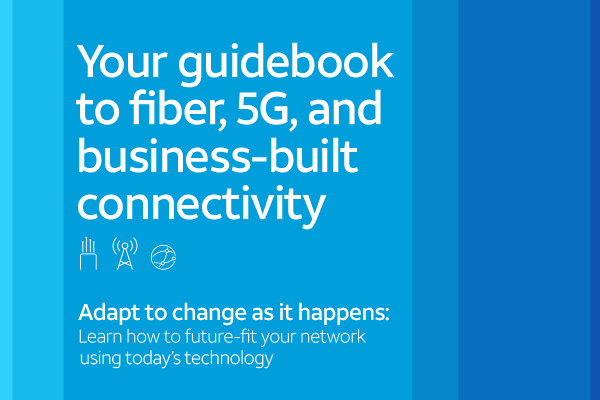DOCSIS 4.0 vs. fiber: Why knowing the difference matters
Today, cable internet providers (CIPs) are struggling to close the gap with the speeds and performance delivered by end-to-end fiber-based connectivity. In a bid to stay competitive, CIPs are launching a new version of the Data Over Cable Service Interface Specification (DOCSIS) as an alternative to fiber-to-the-premises (FTTP). Businesses are trying to puzzle out which is best for them in fiber vs. DOCSIS.
Currently, most CIPs use DOCSIS 3.1 and some are developing version 4.0, which is expected to start launching in major markets in late 2023 or sometime in 2024.
In the matter of fiber vs. DOCSIS, how do they compare? Let’s take a look.
What is DOCSIS?
The first part of the acronym, “data over cable,” succinctly describes what DOCSIS is: it defines how internet data is delivered or sent via cable.
DOCSIS has existed for as long as cable has been used. It provides data into premises—namely the radio and television programming of cable TV. Because of the need to maintain backward compatibility with previous DOCSIS versions, some of the limitations from those early forms of DOCSIS continue to affect the performance of cable networks versus fiber today, which is a big problem for the data-rich applications and devices that we have today. Other limitations include slower cable speeds, modem compatibilities, asymmetric upload and download speeds, data chokepoints, and bandwidth pinch-points that can severely affect network performance.
To many experts, DOCSIS 4.0 is merely cable internet engineered to provide faster speeds and better performance as a stopgap until CIPs can build out their own fiber infrastructure. That cable providers want to eventually transition to fiber is a tacit admission that fiber outperforms cable.
Versions of DOCSIS have gotten faster with each release. Currently, DOCSIS 3.1 is the fastest version available; however, within the year, cable companies anticipate that DOCSIS 4.0 will be launched in carefully chosen test markets. The early buzz from the cable industry is that the DOCSIS 4.0 will rival fiber internet connectivity, but in a head-to-head matchup, the numbers favor FTTP—by quite a large margin. The theoretical maximum speeds DOCIS 4.0 can deliver—possibly—in the future are 10Gbps downloads and 5 Gbps uploads. Current fiber technology, on the hand, can already deliver FTTP symmetrical upload and download speeds of 40Gbps-1Tbps.
Beyond that, there are other reasons to favor FTTP over DOCSIS 4.0.

The future of networking: How to solve for enterprise needs
The future of networking is now. Rick Welday, EVP-Enterprise Markets at AT&T Business, shares the how we’re bringing a new standard of networking to our customers.
Critical weaknesses and fatal flaws in DOCSIS 4.0
There are several reasons why tech influencer Dong Ngo says, “While predicted to be much superior to DOCIS 3.1, DOCSIS 4.0 will likely be still inferior to Fiber-optic."1 Chief among these reasons are: (1) DOCSIS still has asymmetrical upload and download speeds, (2) it has a slower transmission speed than fiber, and (3) the quality of its data-transit performance as compared to fiber.
Let’s take a closer look at each of these weaknesses:
Asymmetrical uploads and downloads
When comparing fiber vs DOCSIS, it’s important to note the differences upload/download speed symmetry. While fiber has symmetrical uploads and downloads—data can be sent and received at the same speeds—DOCSIS implementations are asymmetrical. In other words, you can download data faster than you can upload it back to the network—by a lot. This can hinder high upload speeds for cloud-based services, voice over internet protocol (VoIP), and other data-intensive technologies that enable a business to operate more efficiently.
As Ngo notes, “The biggest shortcoming of DOCSIS is that it has lopsided connection speeds—the upload tends to be one-tenth (or even lower) of the download.”2
This discrepancy in upload versus download speeds is a legacy of the original purpose of DOCSIS: assuming that the user would be downloading audio and video content but would have little cause to upload significant data.
While it’s true that DOCSIS 4.0 will have greater upload and download speeds, bear in mind two things. First, the upload and download speeds will still be asymmetrical—due in part to the need for backwards compatibility with existing systems. Second, those upload and download speeds of DOCSIS 4.0, at their fastest, will still be slower than FTTP.
Slower overall speed
In a head-to-head comparison of bandwidth capacity of fiber vs DOCSIS, transmission speed, and latency, fiber has physics on its side. As tech influencer Brady Volpe says, “Fiber is the winner from a pure physics standpoint as it is inherently easier to provide higher bandwidths in fiber.”3
DOCSIS necessarily dictates radio-frequency (RF) signaling and coding over the cable into the premises, typically over pairs of coaxial cables. In DOCSIS versions between 2.0 and 3.1, transmission was typically half-duplex over the shared coaxial cable (supporting one-way traffic). While DOCSIS 4.0 seeks to allow full-duplex transmission (able to send and receive data at the same time), the available RF speeds and bandwidths over coaxial cabling still cannot hope to match those available to passive optic networks (PONs), i.e., fiber. DOCSIS 4.0 also promises to take advantage of expanded RF spectrum and new developments in coding and multiplexing signals, but even these improvements do not approach the capacity available to fiber.
A telling point in the head-to-head comparison is that DOCSIS 4.0 endeavors to move the fiber handoff closer to the premises to minimize the distance that the signals need to travel over coaxial media. Modern cable delivery systems are hybrid fiber-coaxial (HFC) systems, meaning that the signal is delivered to a central or local distribution point as fiber before being converted to RF coaxial. By trying to move the handoff point closer to the premises, CIPs concede the benefits of the higher capacities and speeds of fiber over cable.
Performance
Performance matters in comparing fiber vs DOCSIS. if you have latency-sensitive, business-critical applications, fiber is really the first choice you want to consider. It’s like the difference between driving a high-performance vehicle or driving an outdated four-cylinder car put together from spare parts by your cousin Larry. As Volpe states, “Reliability is a challenge for DOCSIS due to the mechanical and environmental degradation and failures that occur in the coaxial plant.”4
Besides the mechanical and environmental challenges associated with copper-based wiring, it is also typically shared bandwidth among multiple subscribers. CIPs connect multiple subscribers through a single distribution point by physically splitting cables, meaning that all subscribers must contend for their data bandwidth from within a single stream of data. If demand is high, each user gets a smaller share of the bandwidth. Imagine a cookie jar (the distribution point) filled with cookies (the bandwidth). Cable internet customers “connect” to the distribution point by reaching into the jar. If one or two people are reaching in at the same time, they should have no problem accessing their promised allotment. But if 10 or 15 people all decide to reach into the jar at the same time to pull cookies, things are going to slow down—and may even temporarily shut down.
FTTP, on the other hand, uses fiber cables throughout the network, creating a network with few bottlenecks and disruptions. What does that look like? Imagine a cookie factory that cranks out high volumes of cookies and has a fleet of delivery trucks that will bring you your promised payload. No chokepoints. No bottlenecks. Just smooth, on-time delivery. That’s FTTP.
CIPs can deliver a dedicated circuit to a customer but for a CIP to provide a dedicated circuit, it must provide a dedicated fiber handoff to a single cable at the designated Cable Modem Termination System (CMTS). To provide such access would be at least as costly as a full fiber run to the premises. And even then, the dedicated cable would still be converted to a radio frequency signal (RF) and be limited by the inherent issues plaguing all (RF) cable runs (mechanical, environmental, the need for backward compatibility). For this reason, shared bandwidth for cable is the standard architecture—with all its performance pitfalls.
If I had to trust the fate of my business to either fiber connectivity or DOCSIS 4.0, hands down, I would choose fiber every time. It’s a no-brainer.Share this quote
Other considerations for DOCSIS vs fiber
While cable companies are hyping the arrival of DOCSIS 4.0, it’s important to remember four things:
First – No DOCSIS 4.0 yet
The new technology has not yet been released beyond test markets, nor is it anticipated to be widely released, according to the cable industry, sometime in 2024 at the earliest. So, DOCSIS 3.1—the much slower technology—is still the best option available from cable internet providers.
Second – Guinea pig factor
Although DOCSIS 4.0 performance is being tested in labs under carefully controlled conditions, no one knows how it will handle real data loads once deployed widely in the field. Business customers who sign up for DOCSIS 4.0 will be involved in de facto field trials for the new technology.
Third – DOCSIS perpetually positioned behind fiber
By the time DOCSIS 4.0 rolls out, it’s possible that fiber will be capable of even higher speeds and performance than today. DOCSIS, it seems, will perpetually be chasing fiber in terms of what it can deliver.
Fourth – Customer satisfaction
Net promoter scores (a metric measuring customer loyalty and satisfaction) further tip the scales toward fiber. As AT&T EVP of Technology Operations Chris Sambar noted in Fierce Telecom, “If you look at the net promoter scores that we pay attention to on fiber compared to cable internet, we see between 3 and 5 times higher customer satisfaction and net promoter scores on fiber than we do on cable. People are increasingly dissatisfied with cable, especially as we innovate and make our products better and better.”5
Conclusion thoughts on DOCSIS 4.0 vs. fiber
You will hear a lot of buzz from cable internet providers about how in fiber vs DOCSIS, DOCSIS 4.0 is a game-changer versus fiber. But as you can see, beneath the buzz there’s not much substance. DOCSIS 4.0 is good news for existing cable customers that want to keep their existing cable runs rather than pay for new fiber runs to the premise, but it is still a distant second to actual FTTP. Cable’s primary advantage in the past was the low cost of installation versus fiber, but the cost of upgrades from DOCSIS 3.1 to DOCSIS 4.0 will erase most of that advantage going forward.
With symmetrical uploads and downloads, faster speeds, lower latency, higher reliability, field-proven business-grade technology, and higher customer satisfaction scores, fiber wins every time.
“If I had to trust the fate of my business to either fiber connectivity or DOCSIS 4.0, hands down, I would choose fiber every time,” said Robert Hutchinson, Vice President of Wireline Connectivity at AT&T Business. “It’s a no-brainer.”
Why AT&T Business
See how ultra-fast, reliable fiber and 5G connectivity protected by built-in security give you a new level of confidence in the possibilities of your network. Let our experts work with you to solve your challenges and accelerate outcomes. Your business deserves the AT&T Business difference—a new standard for networking.
Explore our fiber-based connectivity products. Learn more about AT&T Business Fiber and AT&T Dedicated Internet or contact your AT&T Business representative to connect with an expert who knows business.
1Dong Ngo, “Tips on Getting High-Speed Internet: It’s Fiber vs Cable (Coaxial) or ONT vs Modem,” Dong Knows Tech, March 21, 2023, https://dongknows.com/fiber-vs-cable-internet-docsis-modem-vs-ont/.
2Ibid.
3Brady Volpe, “Evolve or Die: Can DOCSIS 4.0 Compete with Fiber?” Broadband Library, Accessed March 22, 2023, https://broadbandlibrary.com/evolve-or-die-can-docsis-4-0-compete-with-fiber/.
4Ibid.
5Diana Goovaerts, “AT&T exec: ‘I almost feel bad’ for cable cos up against our fiber,” Fierce Telecom, February 3, 2022, https://www.fiercetelecom.com/telecom/att-exec-i-almost-feel-bad-cable-cos-against-our-fiber.



Share
Share this with others